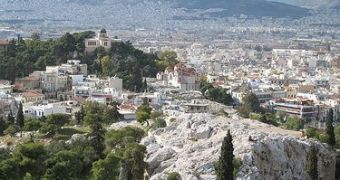Theory says that black and white are not actual colors. Black is rather the absence of color while white contains all colors. Everybody knows or at least has heard that white reflects light and heat, that's why white clothes are cooler than colored clothes, for example. This theory also applies to rooftops, new study by researchers at Lawrence Berkeley National Laboratory found.
This is the first research to use a global model that proved that cool roofs and pavements in cities can help reduce heat inside the city. The benefits of this method would also extend to potentially canceling the global warming effect of almost two years of carbon dioxide emissions.
The explanation is quite simple: as white/light-colored rooftops reflect sunlight and heat, buildings will remain cooler and less air conditioning will be necessary. Black roofs gather heat and transmit it to the surface below, making it less comfortable. A black roof also transmits heat into the city air, raising the urban heat island effect, and directly into the atmosphere, contributing to the greenhouse effect. Having white rooftops is an ancient method used by most Mediterranean and Middle Eastern cities, and their low demand of air conditioning shows that it actually works.
In the US, the energy Secretary Steven Chu, announced that all DOE facilities that need to replace roofs of have new ones build, will have to install cool rooftops. He has also sent letters to every head of the other federal agencies encouraging them to do the same. “Cool roofs are one of the quickest and lowest cost ways we can reduce our global carbon emissions and begin the hard work of slowing climate change,” Chu stated. “By demonstrating the benefits of cool roofs on our facilities, the federal government can lead the nation toward more sustainable building practices, while reducing the federal carbon footprint and saving money for taxpayers.”
The data used for this study came from the NASA Goddard Space Flight Center, that supplied detailed information about regional topography, radiation, evaporation, cloud cover and temperature. Calculations say that installing white rooftops and pavements, in cities with population over 1 million from the northern hemisphere, would achieve an offset of 57 gigatons of CO2 emissions in only one summer. Surabi Menon, staff scientist at Berkeley Lab and lead author of the paper says: “These offsets help delay warming that would otherwise take place if actual CO2 emissions are not reduced.”
Co-author Hashem Akbari, former head of the Berkeley Lab Heat Island Group and now Hydro-Quebec Industrial Research Professor at Concordia University in Montreal, says that this is only a small part of the solution. Even if “two years worth of emissions is huge, it’s just a dent in the problem compared with what we need to do... We’ve been dumping CO2 into the atmosphere for the last 200 years as if there’s no future.”
“Simply put, a cool roof will save money for homeowners and businesses through reduced air conditioning costs. The real question is not whether we should move toward cool roof technology: it’s why we haven’t done it sooner,” says Art Rosenfeld, a Berkeley Lab physicist, member of the California Energy Commission in 2008, that made a similar study two years ago.

 14 DAY TRIAL //
14 DAY TRIAL //